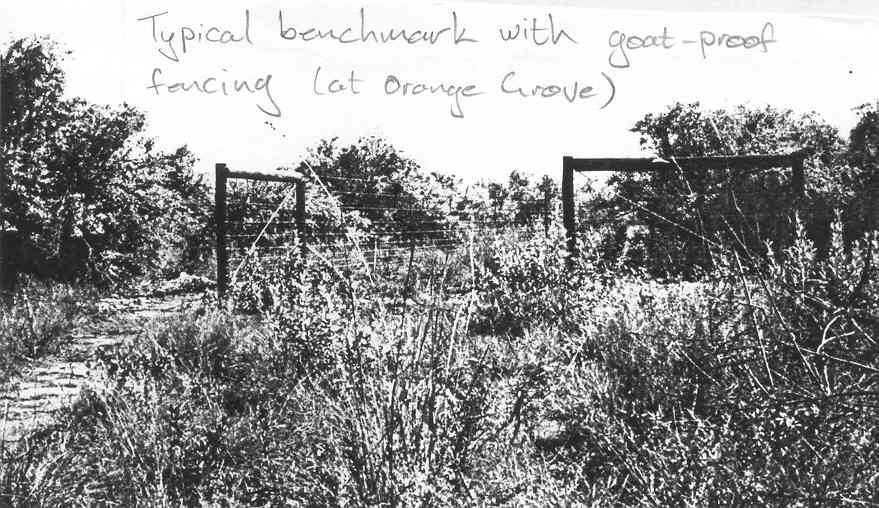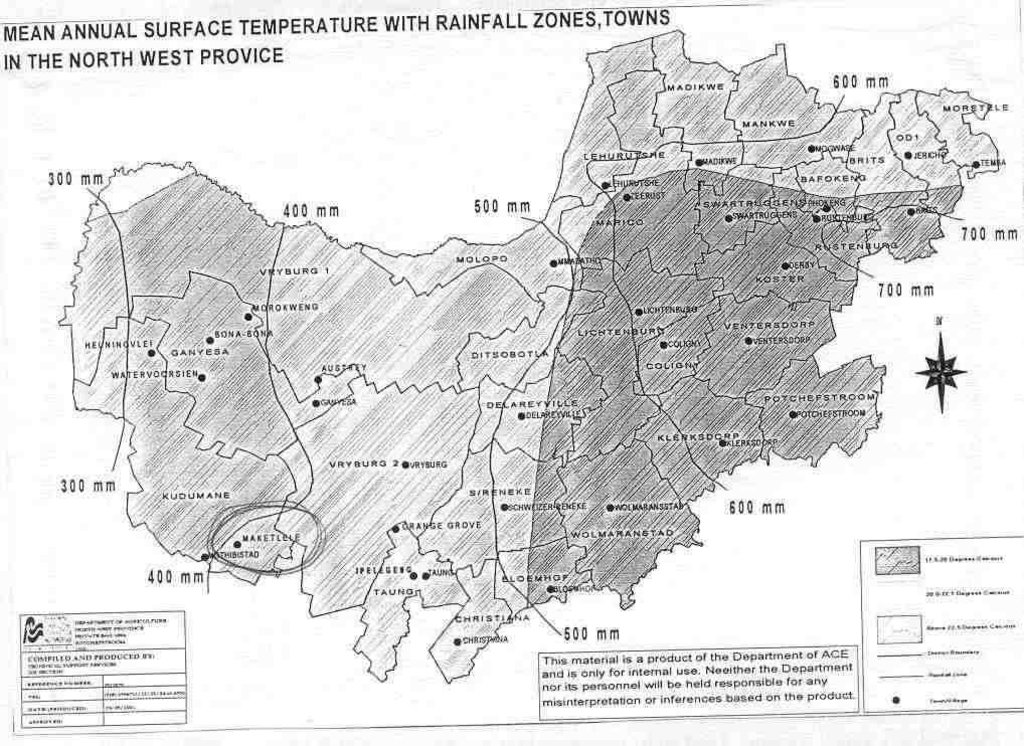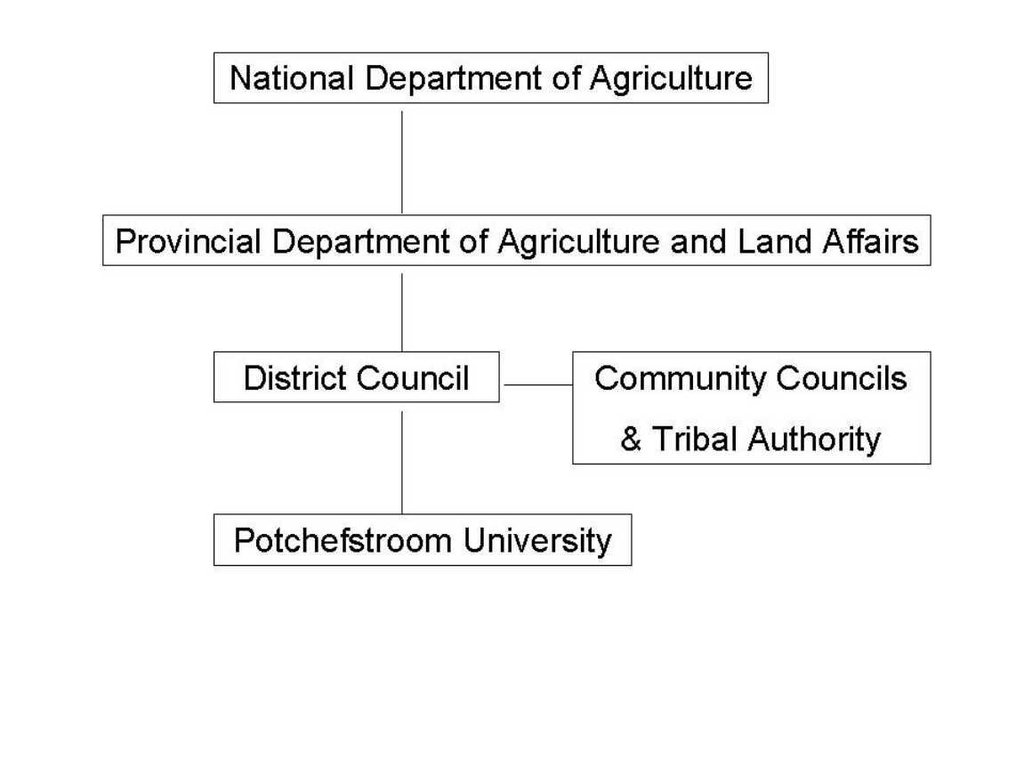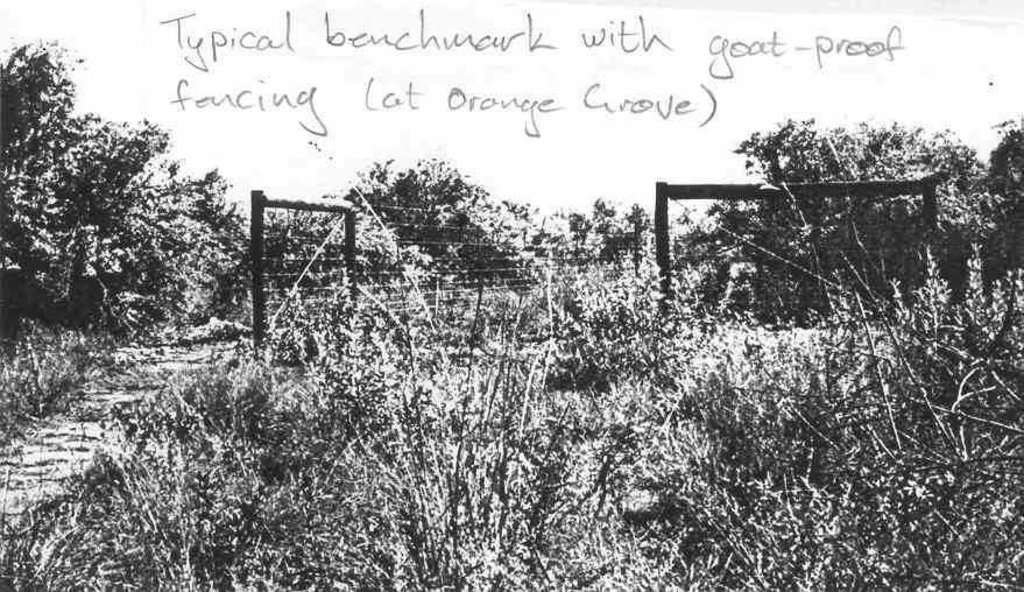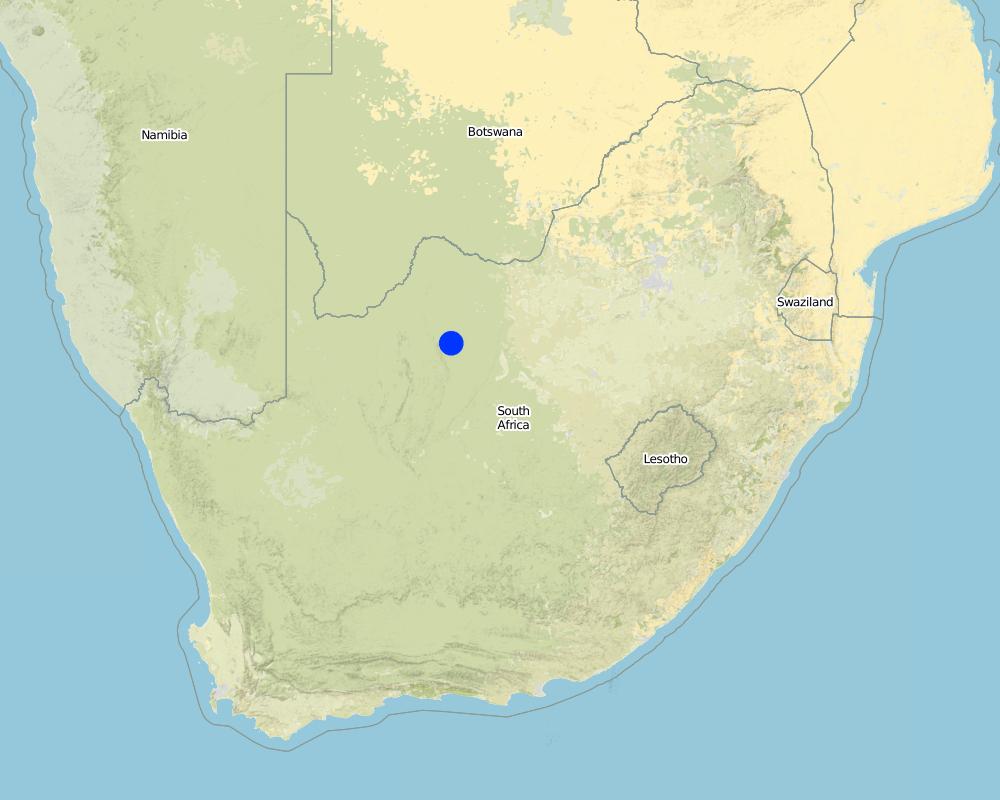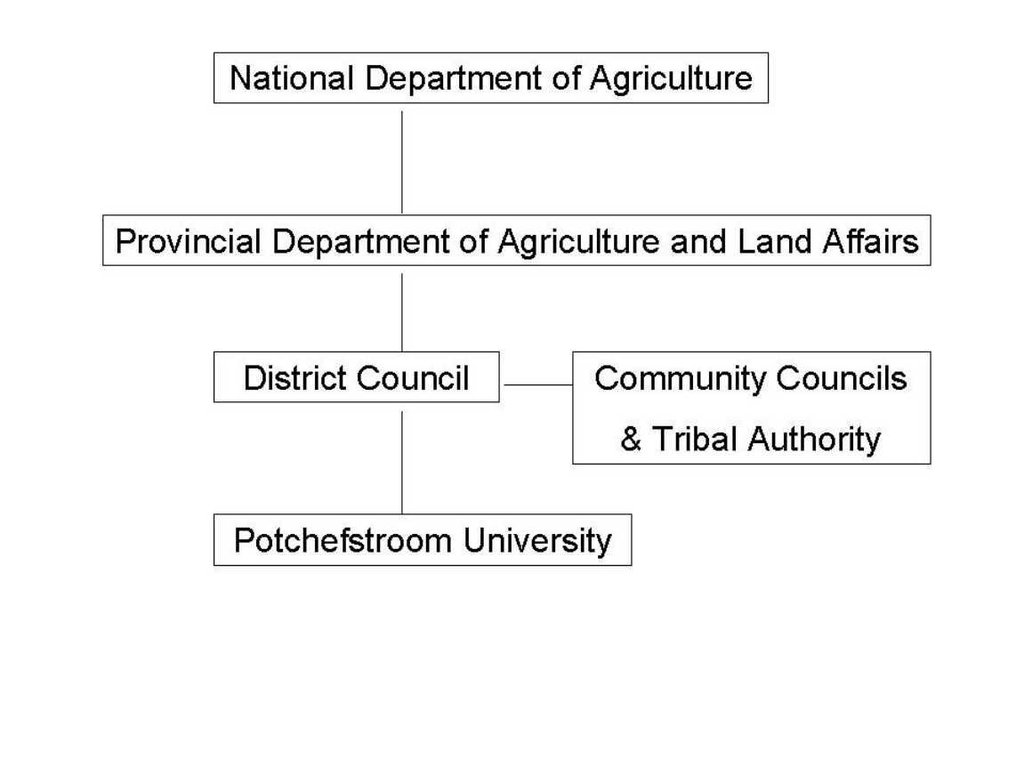Communal stakeholders [جنوب أفريقيا]
- تاريخ الإنشاء:
- تحديث:
- جامع المعلومات: Anja Jansen van Vuuren
- المحرر: –
- المُراجع: Fabian Ottiger
approaches_2339 - جنوب أفريقيا
عرض الأقسام
توسيع الكل طي الكل1. معلومات عامة
1.2 تفاصيل الاتصال بالأشخاص الرئيسيين لمصدر المعلومات والمؤسسات المعنية بتقييم وتوثيق النهج
متخصص في الإدارة المستدامة للأراضي:
اسم المؤسسة (المؤسسات) التي سهلت توثيق/تقييم النهج (إذا كان ذلك على صلة)
Potchefstroom Universiteit vir CHO (Potchefstroom Universiteit vir CHO) - جنوب أفريقيا1.3 الشروط المتعلقة باستخدام البيانات الموثقة من خلال WOCAT
يوافق جامع المعلومات والشخص (لاشخاص) الرئيسي لمصدر المعلومات على الشروط المتعلقة باستخدام البيانات الموثقة من خلال WOCAT:
نعم
1.4 المراجع الخاصة باستبيان(استبيانات) تقنيات الإدارة المستدامة للأراضي
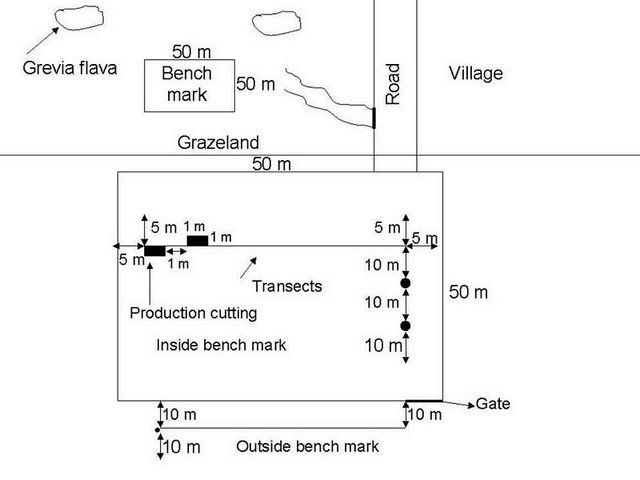
Communal grazing management [جنوب أفريقيا]
Rangeland management of communal grazing land, to improve grazing capacity by applying rotation.
- جامع المعلومات: Anja Jansen van Vuuren
2. وصف نهج الإدارة المستدامة للأراضي
2.1 وصف موجز للنهج
Government funded project aimed at rangeland management to enhance natural recourse management. The community being the key stake holders.
2.2 وصف تفصيلي للنهج
وصف تفصيلي للنهج:
Aims / objectives: The community was approached to show where the benchmarks should be erected. The whole community was informed about the project and how they would benefit from it. Benchmarks were erected by the community, thus creating jobs. Initial surveys were conducted so that later comparison in production and species composition could be made after further surveys. The rotational approach was introduced in a communal system.
2.3 صور عن النهج
2.5 البلد/المنطقة/المواقع التي تم تطبيق النهج فيها
البلد:
جنوب أفريقيا
المنطقة/الولاية/المحافظة:
North West Province
Map
×2.6 تواريخ بدء وإنهاء تنفيذ النهج
أشر إلى سنة البدء:
1998
2.7 نوع النهج
- قائم على مشروع/برنامج
2.8 الغايات/الأهداف الرئيسية للنهج
The Approach focused mainly on SLM with other activities (Cattle improvement. Veld management strategies have been learned. Survey skills learned.)
On-site technology application. Seeing is believing. Community participation. Empowerment of the community to better their own situation. Job creation, community-based natural resource management. Promoting partnerships between public, community and private sectors.
The SLM Approach addressed the following problems: Degraded rangelands, thus insufficient grazing for the cattle.
2.9 الظروف التي تمكن أو تعيق تنفيذ التقنية/التقنيات المطبقة بموجب النهج
توفر/الوصول إلى الموارد والخدمات المالية
- معيق
Availability of government funds.
Treatment through the SLM Approach:
الإطار المؤسساتي
- معيق
Communication between parties.
Treatment through the SLM Approach: More structured and organised meetings.
الإطار القانوني (حيازة الأراضي، وحقوق استخدام الأراضي والمياه)
- تمكين/تمكيني
The existing land ownership, land use rights / water rights greatly helped the approach implementation: The chiefs favoured the approach.
المعرفة حول الإدارة المستدامة للأراضي، والوصول إلى الدعم الفني
- معيق
Lack of community participation during surveys.
Treatment through the SLM Approach: Make a big issue about environmental awareness.
3. المشاركة وأدوار الأطراف المعنية
3.1 أصحاب المصلحة المعنيون بالنهج وأدوارهم
- مستخدمو الأراضي المحليون/المجتمعات المحلية
Participation
Specific ethnic groups: Twana people but only men. The community was asked where the benchmarks should be situated.
- الحكومة الوطنية (المخططون، صانعو القرار)
Funding
- منظمة دولية
Basic framework
إذا كان هناك العديد من الأطراف المعنية، قم بالإشارة إلى الوكالة الرائدة:
The approach - international specialists. The South African approach and application - national specialists. Specification of sites - land users.
3.2 انخراط مستخدمي الأراضي المحليين/المجتمعات المحلية في المراحل المختلفة للنهج
| انخراط مستخدمي الأراضي المحليين/المجتمعات المحلية | حدد من شارك وصف الأنشطة | |
|---|---|---|
| المبادرة/التحفيز | سلبي | workshops/seminars, public meetings; Training for surveys was provided. |
| التخطيط | سلبي | orkshops/seminars; Training |
| التنفيذ | تفاعلي | responsibility for minor steps; Should apply the rotation. |
| الرصد/التقييم | تفاعلي | measurements/observations; Help with monitoring. |
| Research | تفاعلي | on-farm; Benchmarks was erected. |
3.3 مخطط التدفق (إذا كان متاحًا)
3.4 اتخاذ القرار بشأن اختيار تقنية/تقنيات الإدارة المستدامة للأراضي
حدد من الذي قرر اختيار التقنية/التقنيات التي سيتم تنفيذها:
- متخصصون في الإدارة المستدامة للأراضي بشكل أساسي، بعد التشاور مع مستخدمي الأراضي
اشرح:
land user driven (bottom-up).
Decisions on the method of implementing the SLM Technology were made by mainly by SLM specialists with consultation of land users. consultative. The land user did not have the knowledge.
4. الدعم الفني وبناء القدرات وإدارة المعرفة
4.1 بناء القدرات/التدريب
هل تم تقديم التدريب لمستخدمي الأراضي / الأطراف المعنيين الآخرين؟:
نعم
حدد من تم تدريبه:
- مستخدمو الأراضي
- SWC specialists, extensionists/trainers
شكل التدريب:
- من مزارع إلى مزارع
- مناطق العرض
- اجتماعات عامة
المواضيع المغطاة:
Ecological principles, NRM principals.
4.2 خدمة استشارية
هل يملك مستخدمو الأراضي وصولا إلى خدمة استشارية؟:
نعم
وصف/تعليقات:
Name of method used for advisory service: Demonstration; Key elements: Benchmark sites, Learning by doing; 1) Mainly: government's existing extension system, Partly: non-governmental agency. Extension staff: mainly government employees 3) Target groups for extension: land users, technicians/SWC specialists; Activities: Public demonstrations
Advisory service is inadequate to ensure the continuation of land conservation activities; Monitoring does not persist if some one is not doing it with them.
4.3 تعزيز المؤسسات (التطوير التنظيمي)
هل تم إنشاء أو تعزيز مؤسسات من خلال هذا النهج؟:
- نعم، قليلا
حدد المستوى (المستويات) التي تم فيها تعزيز أو إنشاء المؤسسات:
- محلي
حدد نوع الدعم:
- بناء القدرات/التدريب
4.4 الرصد والتقييم
هل يشكل الرصد والتقييم جزءا من النهج؟:
نعم
التعليقات:
bio-physical aspects were regular monitored through measurements
socio-cultural aspects were ad hoc monitored through observations
economic / production aspects were ad hoc monitored through observations
area treated aspects were regular monitored through measurements
no. of land users involved aspects were regular monitored through measurements
management of Approach aspects were regular monitored through measurements
There were no changes in the Approach as a result of monitoring and evaluation
4.5 البحوث
هل كانت البحوث جزءًا من النهج؟:
نعم
حدد المواضيع:
- علم الايكولوجيا
أعط تفاصيل إضافية وأشر إلى من قام بالبحوث:
Vegetation, NRM, production monitoring, soil composition, on-site application.
Research was carried out on-farm
5. التمويل والدعم المادي الخارجي
5.1 الميزانية السنوية لمكون الإدارة المستدامة للأراضي في النهج المذكور
إذا لم تكن الميزانية السنوية الدقيقة معروفة، قم بالإشارة إلى نطاقها:
- 100,000-10,000
التعليقات (على سبيل المثال المصادر الرئيسية للتمويل/الجهات المانحة الرئيسية):
Approach costs were met by the following donors: government (national - Department of Agriculture): 80.0%; national non-government (University): 20.0%
5.2 الدعم المالي/المادي المقدم لمستخدمي الأراضي
هل حصل مستخدمو الأراضي على دعم مالي/ مادي لتنفيذ التقنية/ التقنيات؟:
نعم
5.3 إعانات لمدخلات محددة (بما في ذلك العمالة)
إذا كان العمل من قبل مستخدمي الأراضي مدخلاً جوهريًا، فهل كان:
- مدفوع نقدا
التعليقات:
Job creation incentive.
5.4 الائتمان
هل تم توفير ائتمان في إطار نهج أنشطة الإدارة المستدامة للأراضي؟:
كلا
6. تحليل الأثر والتصريحات الختامية
6.1 آثار النهج
هل ساعد النهج مستخدمي الأراضي على تنفيذ وصيانة تقنيات الإدارة المستدامة للأراضي؟:
- لا
- نعم، قليلا
- نعم، باعتدال
- نعم، إلى حد كبير
Rotational grazing system was adopted.
Did other land users / projects adopt the Approach?
- لا
- نعم، قليلا
- نعم، باعتدال
- نعم، إلى حد كبير
Other regions in North West Province are following the example.
6.3 استدامة أنشطة النهج
هل يمكن لمستخدمي الأراضي المحافظة على استدامة ما تم تنفيذه من خلال النهج (بدون دعم خارجي)؟:
- نعم
إذا كانت الإجابة بنعم، صف كيف:
Extension officers learned from the specialists.
6.4 نقاط قوة/مزايا النهج
| نقاط القوة/ المزايا/ الفرص من وجهة نظر مستخدمي الأراضي |
|---|
| Better grazing. (How to sustain/ enhance this strength: Keep to the rules of rotational grazing. Keep cattle out of resting velds.) |
| Specialists help. (How to sustain/ enhance this strength: The specialists made surveys easy. Assist in erecting.) |
| نقاط القوة/ المزايا/ الفرص من وجهة نظر جامع المعلومات أو غيره من الاشخاص الرئيسيين لمصدر المعلومات |
|---|
| The committed ADC manager. (How to sustain/ enhance this strength: Keep him motivated through communication.) |
| LandCare. (How to sustain/ enhance this strength: he buzz words were introduced and community was made aware of the environment.) |
| Interaction between different cultures. (How to sustain/ enhance this strength: Specialists and communities were introduced to one another.) |
6.5 نقاط الضعف/ العيوب في المنهج وطرق التغلب عليها
| نقاط الضعف/ المساوىء/ المخاطر من وجهة نظر مستخدم الأراضي | كيف يمكن التغلب عليها؟ |
|---|---|
| Specialists are very remote. | Not always reachable. |
| Reduction of cattle numbers. | Resistant to reducing wealth. |
| نقاط الضعف/ المساوىء/ المخاطر من وجهة نظر جامع المعلومات أو غيره من الاشخاص الرئيسيين لمصدر المعلومات | كيف يمكن التغلب عليها؟ |
|---|---|
| Linguistic abilities not sufficient. | Learn to speak Tswana. |
| Times delays. | The sites are a bit remote and the people only drive during working hours. |
| NRM application should be sustainable. | Not only based on incentives, but the benefits should be realised. |
7. المراجع والروابط
7.1 طرق جمع/مصادر المعلومات
- زيارات ميدانية، مسوحات ميدانية
- مقابلات مع مستخدمي الأراضي
الروابط والوحدات المواضيعية
توسيع الكل طي الكلالروابط

Communal grazing management [جنوب أفريقيا]
Rangeland management of communal grazing land, to improve grazing capacity by applying rotation.
- جامع المعلومات: Anja Jansen van Vuuren
الوحدات المواضيعية
لا يوجد وحدات مواضيعية


